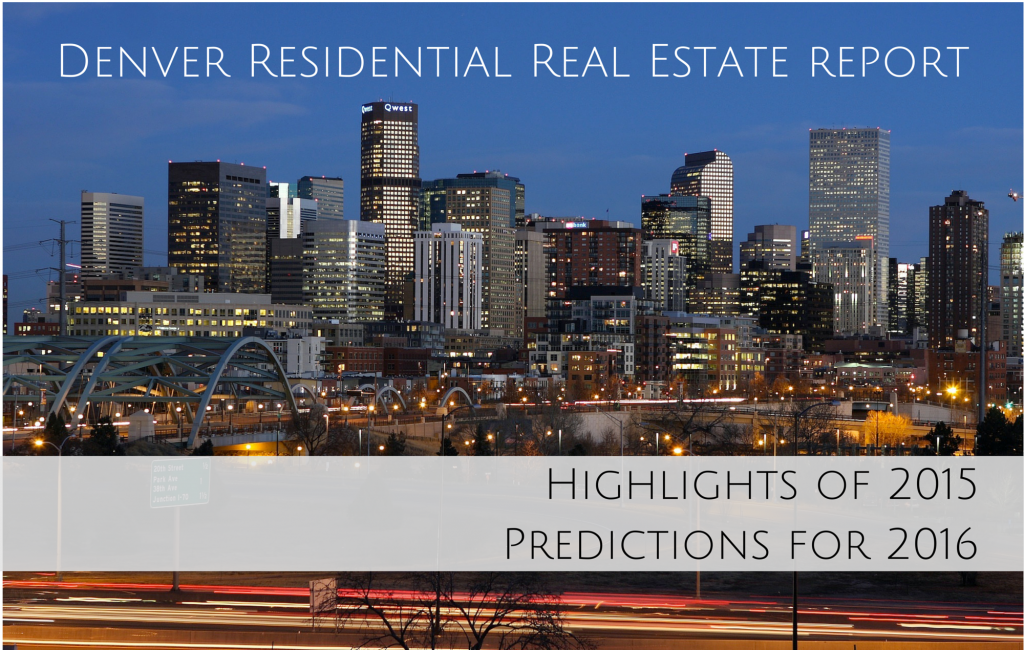The Denver 100 provides this Annual Real Estate Report as a service to our clientele to give the current trends in the Denver residential real estate market and a resource to predict the future housing direction in our marketplace.

Residential Real Estate Report
DENVER METRO AREA SINGLE FAMILY HOUSING
- 59,179 single family and condominiums sold in 2015 compared to 56,910 that sold in 2014 or a 4% increase in the number of homes closed.
- At Year End 2015 there were 5,501 active single family homes for sale compared to the beginning of 2015 which had 5,342, an increase of 3% in inventory over last year at this time.
- The average price of a single family home in the Denver Metro Area ending in 2015 is $400,361 compared to $360,196 ending in 2014, which is an 11% increase in price for the mix of properties sold. By comparison, 2006 had a single family average price in Denver of $317,112.
- The average days on the market for 2015 is 26 compared to 35 one year ago.
- The selling price obtained compared to list price is 99.1%. What this means is that buyers were willing to pay full price or more to buy a home in 2015.
- The absorption rate for single family homes in the Denver Metro Area with 2015 year-end inventories is 1.11 months. As the inventory decreases so does the absorption rate. This inventory month supply will rise during the spring and summer seasons.
- The $250,000 to $500,000 price range had the most single family home sales with 27,198 homes closed in 2015, creating an absorption rate of 32 days of inventory. Below 6 months of inventory typically indicates prices will increase.
- Conversely the $1 million and above price range had a total of 1,290 homes closed in 2015, creating a current absorption rate of 6.9 months of supply. This is a decrease of 14% from 12 months ago, and moving in the right direction to have luxury properties start to increase in price for the first time in 8 years.
2015 Highlights and 2016 Predictions for Real Estate
- Sellers continue to be in the drivers’ seat in the sale negotiations of homes, especially priced below $500,000.
- The briskness of sales and the amount of buyers buying was the hottest topic in 2015. The inventory continued to reduce during the year. When inventories drop at record levels, buyers make their moves in the market to purchase at a brisk pace.
- The increase in home prices across the metro area has helped people feel a little wealthier as more homes have more equity than they have had over the last 8 years.
- 2015 sold data reflects 42,571 single family units closed this year compared to 41,748 homes in 2014. This 2% decrease indicates sales for the Denver Metro area are stabilizing and does indicate a more conservative growth moving forward into 2016.
- The number of condo’s closed data for 2015 is 16,608 units. This is a 10% increase over 2014 which recorded 15,162 condos closed. Clearly the increase in condo sales is a direct result of the increase in average sales price for Denver causing buyers to move to condos as a price point they can afford. However, the slowing number of the increase is because there is no condo construction really happening in the Denver metro area.
- The number of sold properties in Denver for 2015 priced below $500,000 is 50,864. Homes priced below $500,000 make up 83% of all the sales in Denver.
- All properties priced above $500,000 that sold in 2015 is 10,470 homes/condos compared to 2014 which had homes at a 10% increase in sales.
- Attached home (condo) sales in 2015 recorded 16,608 units sold. Most of the sales of condos were under $500,000, making up 97.46% of all the condos sold.
- Average Price is the third Highlight of 2015, marking a strong increase to recapture lost equity in homes.
- The median price of a single family home and condominiums by the end of 2015 is $311,500 compared to $285,000 at the end of 2014 or a 9.3% increase.
- Price rises when days on the market shortens because buyers are making a more aggressive buying position. The Days on the market in 2014 was 39 for a home and today it is 33 or a 15.4% decrease in Days on the Market.
Four Future Thoughts About Where the 2016 Housing Market Will Be
1. Inventories will start to rise over 2015 levels, except for the hottest neighborhoods in Denver. The reason for an increase of the inventory in the housing market is an increase of equity in the real estate market has occurred over the last several years, which is giving the freedom for a segment of sellers to place their home on the market and move. Today’s home Prices have more than offset the negative adjustments made during the 2008 to 2012 years. There are a sufficient number of households who could not take advantage of refinancing at the lower interest rates and may consider selling now that they have a chance to get out without bring cash to closing. Finally, unemployment for 2016 is going to be improved in Colorado and anticipated to be in the 4-5% range for unemployment for the upcoming year which brings some additional buyers to the buyer pool, creating a situation for sellers to capture the Right Buyer for their home.
2. Sales will decrease slightly for 2016 with sales to be approximately 55,000 single family and condos sold. 2015 experienced a continued abnormal amount of buyers entering the market due to low interest rates, stability in their personal economic situation and housing prices that were at 2006 levels. As the 59,179 single family and condo homes closed in 2015, 2016 will be 2-3% less in number of units closed, which would still make 2016 one of the highest number of sales in a decade. The primary reason the housing market will see fewer buyers the second half of 2016 is that 1: Interest rates will be higher than today and we predict 4.4% to 4.6%. 2: Secondly, the easing of the borrowing guidelines still requires such rigid proof of ability to buy that self-employed or newly employed workers do not meet most of the guidelines causing the buyer pool to retreat some in 2016. 3: The inventory of properties continues to remain lower than normal, causing buyers to rent versus buy in 2016. This all gives for the number of units predicted to close to be less than 2015. However, due to interest rates holding steady for at least the first 6 months of 2016, we should see the same number of homes close early in the year as in 2015.
3. Prices of homes below $500,000 will increase 3-4% in 2016 depending upon the location. We do not see any prices of homes below $500,000 reducing in 2016 unless a major job loss occurred in one area, like the airport causing the housing in sub area was affected by an economic occurrence. Prices above $500,000 are finally on the rise. We see prices rising up to $2M depending upon the geographic location of a home. Location in upper end priced homes will really dictate the increase. For example, a $750,000 home in Cherry Creek is liable to go up at a faster rate than the same $750,000 in suburbs of Douglas County. Why would this be? It goes back to the comfort level of the buyer pool who will pay more for location than worry about value. With interest rates, even for jumbo loans at record low levels, some buyers who have economic stability in their life can see a bargain even at higher prices due to location. The luxury market is improving and will slowly have appreciation especially in the suburbs where luxury living becomes a destination not generally a visited location with urban amenities. Buyer behavior has changed and buyers are more interested in convenience than mega mansion size. Hence housing in Denver moves faster than Evergreen.
4. The First Time Home Buyer Pool will increase in 2016, as Millenniums find stability in jobs, relationships and reduce personal debt.
Thank you for allowing The Denver 100 to be your resource for the Denver housing market. We are grateful for the opportunity to serve your real estate needs in 2016.
For a more detailed report, including more Denver housing statistics, click here.
